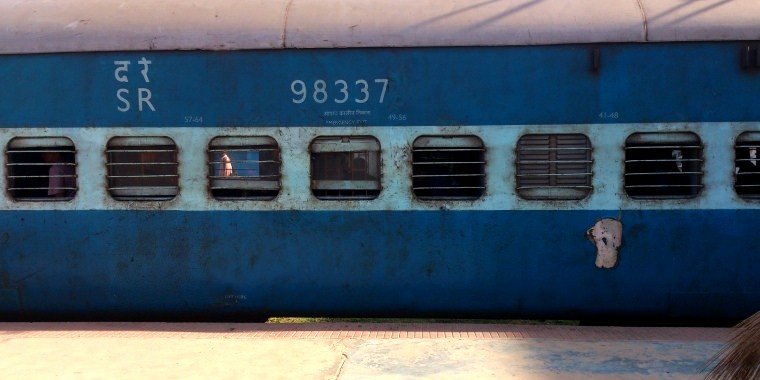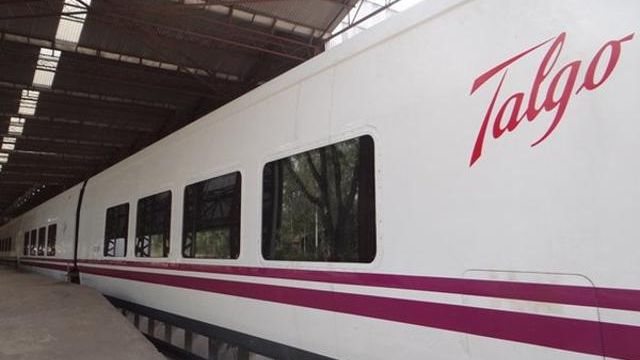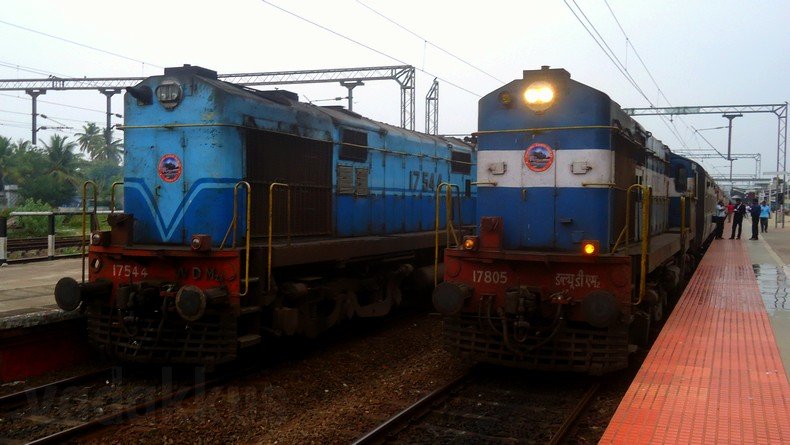How Indian Railways fell behind the rest of the World

Southern Railway’s Salem – Erode section, part of the Jolarpettai – Coimbatore mainline is a relatively straight line resting on particularly solid terrain and is one of South India’s “highest speed” stretches. It was built by the British Great Southern of India Railway company (GSIR) in 1861 and has since been one of the most important routes in South India. The 1931 Bradshaw (timetable) shows us that during those days, the 45 Blue Mountain Express from Madras to Ooty took exactly 1 hour and 3 minutes to cover the 62 kilometers (35 miles) between Salem and Erode behind a WP “Pacific” steam engine. Today, 83 years later, it successor the 12671 Nilagiri Express takes exactly three minutes less (1 hour) to cover the same distance with a 6350 hp WAP7 electric locomotive and advanced signaling and controlling systems. The most prestigious train in India, the Howrah – New Delhi Rajdhani when introduced in 1969 covered the distance in 17 hours, the fastest train at its time. Today, 45 years later, it still takes the exact 17 hours for its run. The Kerala Express which took 46.5 hours to travel from Trivandrum to New Delhi when it was introduced (as the KK Express) in 1978 today takes four hours more to cover the same distance. On a whole, the speeds of our trains have not increased from what they were at the time of the British! This presents a kind of antithesis, doesn’t it? As we have seen everywhere else in the world, as time goes by and technology gets better, aren’t trains along with everything else supposed to get faster and travel times decrease instead of the other way around? Everything seems to have gotten faster and better with time except Indian Railways (on a whole). There seems to have taken place a kind of “reverse development” or “negative growth” in India, resulting in us being left far, far behind by the world.
371 Ernakulam – Trivandrum Fast Passenger leaves Kollam, 1978! Today’s Island Express has its same speed.
In the last part we saw all the reasons for why trains in India are slow. Now the question is how it came to that. Why did India never design new coaches, build new tracks to meet capacity demands or upgrade our tracks to enable increase in speeds? Why did train speed increases and other developments in India never take place in the positive? Why was there stagnation and negative growth in India while the rest of the world rushed ahead? Why did all the development that took place in Japan and Europe never happen in India? Why did our designs and class comforts of our trains never improve? In short, why didn’t Indian Railways (and India) ever develop? The reason for all this is almost all politics and a little economics intertwined with the history of India and the Indian Railways.
How India Started Off Well But Then Fell Behind
Like I said before, we had started off pretty well. We had rebuilt the entire network, brought in standardization and cost-effectiveness and introduced a couple of really good reform initiatives. There were many innovations, solid positive strides and plans and vision in infrastructure, rolling stock, manufacture and other sectors of the Indian Railways. We were almost at par with most of other railway systems in the world until the late 1960s. And then we stopped innovating and changing and slipped into the complacency of the status quo, staying where we were, stuck in the 1960s until the late 1990s. It is telling that we took 30 years to come out with a new kind of locomotive (WDM2 in 1962 to WDM3A in 1994). Most projects undertaken after 1970 (CORE, Unigauge etc) were mainly aimed at only reducing costs and overheads of the railways and to streamline operations. The Konkan Railway and massive computerization of passenger reservation systems were the only projects that otherwise stood out. Nobody at all cared about things like speed, efficiency, aesthetics, punctuality and of course, passenger comfort of trains in India.
Many people do not know that India had successfully tested trains to run at 160 kph way back in 1963! If that experiment was followed up and put into practice, we could easily have had trains running at 200 kph on our standard tracks today and we would have very well been into almost finishing a very-high speed railway (bullet train) network. In a parallel universe it might have already happened, but in ours it never did and our train speeds never crossed the 110 kph mark. Yes, sure we have the Bhopal Shatabdi that runs at 150 kph for around half an hour on a selected stretch and there are some other stretches that are cleared for 130 kph runs, but all these are exceptions rather than the rule. 87 kph is the average speed of all the fastest trains in India (Howrah, Mumbai, August Kranti Rajdhanis, Sealdah Duronto, Bhopal Shatabdi). After the growth times of the 1960s, “lost decades” of India (1970-1990) happened. World economies boomed and many previously piss-poor nations became “rich” seemingly out of nowhere while India’s growth all but stopped and technological innovation and growth became non-existent. Those two decades were India’s dark ages.
Left: Swiss Federal Railways (SBB CFF FFS) Re 620 (Re 6/6) locomotive, 10700 hp. Right: Indian Railways WAM4 class locomotive, 3850 hp. Both from 1972.
World War 2 and the Economics of Fast Trains, Highways etc.
After World War 2 ended, western countries threw everything they had into rebuilding their economies, putting aside whatever happened during the war. The resulting economic boom lasted 30 years and was the golden age in the world’s economic history, when trade skyrocketed and money flowed between countries. A basic necessity for that growth to be achieved and sustained was efficient and fast transportation systems to move goods, services and people across countries and continents, to drastically cut down time loss enabling more work to be done, more goods to be transported, more money to flow. They understood this and first built these transportation systems, which had to be expanded and made more efficient to keep up with the pace of growth. The social setup of the west also changed drastically during this period. The baby boom of the 1950s and 60s created a young liberal population with a world view much different from those of their parents. They enjoyed a substantially higher standard of life fueled by all the trade and innovation of the post-WW2 boom. Initial economic growth leads to more production, more money, more jobs and more services for the people who in turn with education and exposure will gain more awareness about their rights and will stand up and demand more facilities from their governments. This is what is called the virtuous cycle. The governments, even if they were “extractive” as Daron Acemogulu calls them in his epic work “Why Nations Fail“, have to fall in line and listen to their citizens whom they are ultimately responsible for and develop inclusive institutions foregoing their authoritarian power. All that led to the creation and expansion of complex highway systems, airports, sea ports and railway systems, high speed and otherwise, to abet and consummate development and to increase standards of life for the citizens. Yes, the reasons for all the development in those countries were mostly economic, thanks to a free and liberal market.
Japan, France, Germany, China and other countries which boast of ultra-high speed trains traveling at constant 350 kilometers per hour speeds did not just suddenly start running such high-tech trains one fine day. All of them except China had already trains running at 150 kph well before the 1960s. What they had achieved was only the natural progression from slow speed to express to high speed to very high speed over time, mainly to facilitate people movement to help their growing economies. Japan faced the problem of being unable to cope with the demand for mass-movement of its newly prosperous population emancipated in the wake of its booming post-WW2 economy. This rush could not be met even by a Boeing 747 Jumbo taking off every half an hour. The result was the Shinkansen. France closely followed Japan by upgrading thier already 160 kph railway lines to 220 kph, culminating in the introduction of the TGV in 1981. Within a decade, all major railway systems in Europe had upgraded to high speed, because once the trigger had been pulled at one end there is no going back. It was either follow the leader or get left behind. However, USA followed a different approach from Europe.
Low on Trains but High on Highways. Welcome to ‘Merica!
Why India and Indian Railways Never Picked Up Speed
So why did all this never happen in India? When India got its independence in 1947, we were actually on a similar footing or even better off than many European countries laid waste by World War 2. It would be fair to say that India, Europe and Southeast Asia got off at the same starting position in building their economies after the war/independence. Then why did we falter and the others race ahead? The answer is the path we took for building our country. We have seen that today’s developed countries had to increase their train speeds over time to meet the demands of faster transportation speeds necessary to keep up the generation of capital inflow and pace of growth through trade. In India, this “growth through trade” and the accompanying virtuous circle never happened. Intense mistrust of foreign companies and capital after four centuries of foreign domination prompted new governments of independent India to adopt a policy of shutting out India from the rest of the world and of restricting trade with the aim of developing a “self sufficient home grown economy” which would come up with “world class” Indian products to offer to the world. The government almost stopped imports and dictated everything from the kind, type and quantity of products to be manufactured to where and at what price there were to be sold. Nobody wanted to trade with us as we never had anything to offer anyway. This is laughable since ever since ancient times India was world famous for its trade, starting from the Malabar Coast down south to the Silk Roads up north!
Without a free, demand and innovation driven economic atmosphere which never created any goods and services to be transported at speed, there simply existed no need for India to develop any kind of transportation infrastructure, high speed or otherwise. We were trying to manually “eradicate” poverty through “social” means first and then develop infrastructure, and after 67 years we have spectacularly failed at both. Also, our “closed” economy was convenient for our kleptocratic “rulers” to block trade and hence development to keep the masses under ignorance to meet their own ends. Since the populace remained ignorant in 1970, they never knew that trains were traveling at 160 kph in distant countries. There was no natural progression of train speeds like in Japan or Europe since the economy that would fuel it never grew, people who would be riding on it never earned enough to afford or support them and everything stagnated in a vicious circle. Even if trains were to travel at 160 kph they would not have served any purpose and failed as there was almost no one who could have afforded these trains regularly. And this lethargy was precipitated everywhere. Even today, Indian Railways manages to construct around 172 km of new track a year, while the British managed to build a huge 570 km in a year! All sectors in India lay stagnant but the railways were among the worst affected due to this lack of innovation. This is why our trains never picked up speed and remained at 50 kph average speeds along with poor aesthetics and systems. While developed nations use ultrasonic technology to detect track failures, we still have people walking along the track tapping at the rails with hammers.

The liberalization of the Indian economy of 1991 was a watershed. Millions of Indians suddenly had access to foreign goods and travels and aspirations soared sky high. The well-spending Indian at one go ditched everything that reminded them of the dark socilast-communist era and embraced globalization. The railways also tried to keep up with the times with improved locomotives (WDP4 / WDG4 EMDs, WAP5/7, WAG9), better looking and aesthetically designed coaches (LHB) increased speeds etc, but these cosmetic upgrades did little to bring in much wanted revenue. The average affluent Indian remained in contempt of the railways and the ordinary common Indian, (and not the much touted middle class) continued to suffer the indignation of ridiculous services because they hadn’t reaped the benefits of liberalization and didn’t know better or weren’t allowed to raise their voices demanding better services. A large chunk of the old India still lives on, and these social causes are a major reason why our pace of development remains abysmally slow, because of our failure to take the masses on board our LHB trains. This is why our trains continue to be the rolling dinosaurs they are, which will be explained in more detail in the next part.





Best article I’ve read in a while, One of the few from an Indian on domestic issues, First one on Indian Railways. KEEP IT UP.
very nice article. I have travelled in Europe to china to japan. most of the development there took only after 1960’s and 70’s. Even China was lacking behind our railways before 70’s. but it rose suddenly in 80’s and have become the country with highest high speed train network in the world.
It is said that the country can grow based on the principles and ideologies of political leadership. had we opened the economy in 1960’s, perhaps India would have started seeing the development in 70’s and 80’s itself which would have benefited the transportation systems. Railways should design the policies conducive for the investing companies so that we see major development like our golden quadrilateral of National highways with workable profit sharing basis. until it happens we have to content with 55kmph superfast category trains